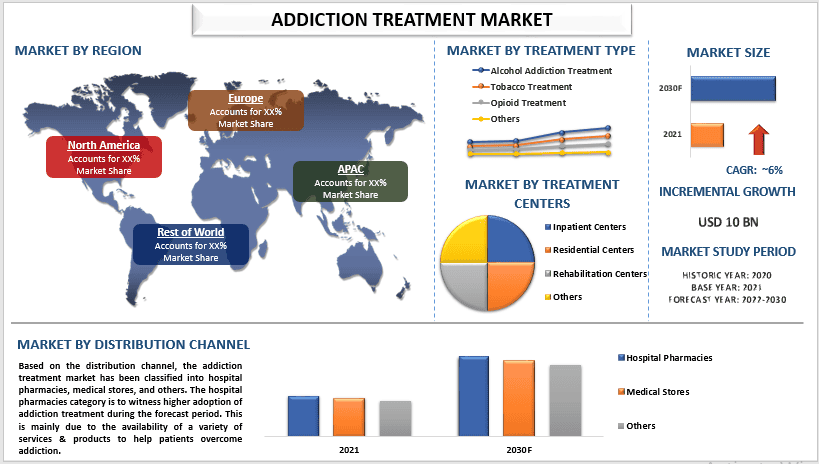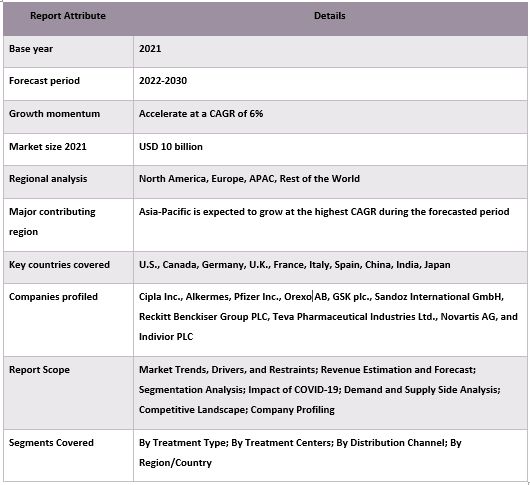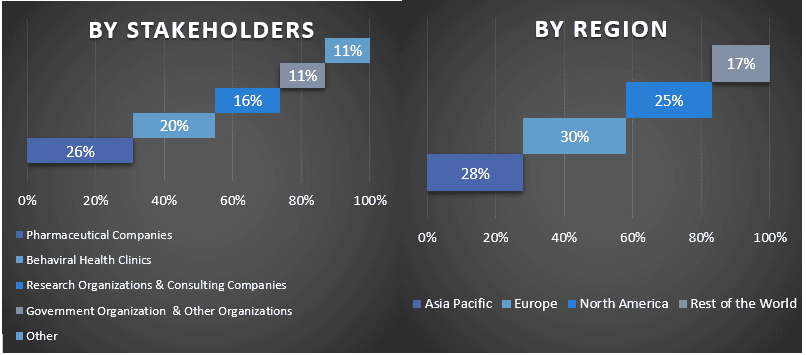- Home
- About Us
- Industry
- Services
- Reading
- Contact Us
Addiction Treatment Market: Current Analysis and Forecast (2022-2030)
Emphasis on Treatment Type (Alcohol Addiction Treatment, Tobacco Treatment, Opioid Treatment, and Others); Treatment Centres (Inpatient Centres, Residential Centres, Rehabilitation Centres, and Others); Distribution Channel (Hospital Pharmacies, Medical Stores, and Others); and Region/Country

The addiction treatment market was at USD 10 Billion in the year 2021 and is expected to grow at a strong CAGR of around 6% during the forecast period (2022-2030) owing to an increase in funding for research and development in the field, growing demand for evidence-based treatment options, and expansion of the healthcare industry and the availability of insurance coverage for addiction treatment. Moreover, there are several other factors such as the increasing prevalence of addiction and substance abuse disorders, leading to a growing demand for addiction treatment options. Further on, development in medical technology and the development of new treatment methods have expanded the range of treatment options available to individuals seeking help. Also, the increasing public awareness of mental health disorders due to alcohol or other harmful drugs, and the use of online & telehealth services, offer accessible treatment options for individuals. Moreover, there has been an increasing demand for evidence-based treatment options, including personalized & holistic treatment approaches that consider individual preferences. Additionally, addiction treatment is a rising incidence of co-occurring mental health disorders, leading to a need for integrated treatment approaches that address both addiction and mental health conditions.
Some of the major players operating in the market include Cipla Inc., Alkermes, Pfizer Inc., Orexo AB, GSK plc., Sandoz International GmbH, Reckitt Benckiser Group PLC, Teva Pharmaceutical Industries Ltd., Novartis AG, and Indivior PLC Several M&As along with partnerships have been undertaken by these players to facilitate customers with hi-tech and innovative products/technologies.
Insights Presented in the Report
“Amongst treatment type, the smart appliances segment held a dominating share of the market in 2021”
Based on treatment type, the market is segmented into alcohol addiction treatment, tobacco treatment, opioid treatment, and others. Amongst these, the tobacco treatment category is expected to grow at the fastest CAGR during the forecast period. This is due to the increasing awareness of the health risks associated with tobacco use, rising healthcare costs, and the expansion of insurance coverage for addiction treatment, and the rising prevalence of tobacco addiction among the population. Furthermore, in 2021, according to the World Health Organization (WHO), more than 8 million people die prematurely due to tobacco use each year and more than 7 million of those deaths are the result of direct tobacco use.
“Amongst treatment centers, the wireless addiction treatment technology held the majority share of the market in 2021”
By treatment centers, the market is segmented into inpatient centers, residential centers, rehabilitation centers, and others. Among these, the rehabilitation centers category captured the majority share of the addiction treatment market in 2021. This is mainly due to the rehabilitation centers are the most preferred choice for patients who are required to undergo long-term addiction treatment because they offer more treatment options, amenities, and specialized care, such as dual diagnosis. Furthermore, rehabilitation centers offer a range of evidence-based therapies and counseling to help individuals address the underlying causes of their addiction. These may include individual and group therapy, cognitive-behavioral therapy, motivational interviewing, and family therapy. these factors are also driving the growth of this market during the forecast period.
“APAC is expected to grow at the fastest CAGR during the forecast period”
The increasing incidence of substance abuse disorders and addiction. The region has a large population and a rising middle class, leading to a higher demand for addiction treatment services. Moreover, increasing government initiatives to improve access to healthcare services and the growing public awareness of addiction and mental health disorders are driving the growth of the market. In recent years, there has been a significant increase in the number of addiction treatment centers and hospitals in the region, indicating the growing market demand.
Addiction Treatment Market Report Coverage

Reasons to buy this report:
- The study includes market sizing and forecasting analysis validated by authenticated key industry experts.
- The report presents a quick review of overall industry performance at one glance.
- The report covers an in-depth analysis of prominent industry peers with a primary focus on key business financials, product portfolios, expansion strategies, and recent developments.
- Detailed examination of drivers, restraints, key trends, and opportunities prevailing in the industry.
- The study comprehensively covers the market across different segments.
- Deep dive regional level analysis of the industry.
Customization Options:
The global addiction treatment market can further be customized as per the requirement or any other market segment. Besides this, UMI understands that you may have your own business needs, hence feel free to connect with us to get a report that completely suits your requirements.
Table of Content
Research Methodology for the Addiction Treatment Market Analysis (2022-2030)
Analyzing the historical market, estimating the current market, and forecasting the future market of the global addiction treatment market were the three major steps undertaken to create and analyze the adoption of addiction treatments in major regions globally. Exhaustive secondary research was conducted to collect the historical market numbers and estimate the current market size. Secondly, to validate these insights, numerous findings and assumptions were taken into consideration. Moreover, exhaustive primary interviews were also conducted, with industry experts across the value chain of the global addiction treatment market. Post assumption and validation of market numbers through primary interviews, we employed a top-down/bottom-up approach to forecasting the complete market size. Thereafter, market breakdown and data triangulation methods were adopted to estimate and analyze the market size of segments and sub-segments of the industry pertains to. Detailed methodology is explained below:
Analysis of Historical Market Size
Step 1: In-Depth Study of Secondary Sources:
Detail secondary study was conducted to obtain the historical market size of the addiction treatment market through company internal sources such as annual reports & financial statements, performance presentations, press releases, etc., and external sources including journals, news & articles, government publications, competitor publications, sector reports, third-party database, and other credible publications.
Step 2: Market Segmentation:
After obtaining the historical market size of the addiction treatment market, we conducted a detailed secondary analysis to gather historical market insights and share for different segments & sub-segments for major regions. Major segments are included in the report as treatment type, treatment center, and distribution channel. Further country-level analyses were conducted to evaluate the overall adoption of testing models in that region.
Step 3: Factor Analysis:
After acquiring the historical market size of different segments and sub-segments, we conducted a detailed factor analysis to estimate the current market size of the addiction treatment market. Further, we conducted factor analysis using dependent and independent variables such as treatment type, treatment centers, and distribution channel of the addiction treatment market. A thorough analysis was conducted for demand and supply-side scenarios considering top partnerships, mergers and acquisitions, business expansion, and product launches in the addiction treatment market sector across the globe.
Current Market Size Estimate & Forecast
Current Market Sizing: Based on actionable insights from the above 3 steps, we arrived at the current market size, key players in the global addiction treatment market, and market shares of the segments. All the required percentage shares split, and market breakdowns were determined using the above-mentioned secondary approach and were verified through primary interviews.
Estimation & Forecasting: For market estimation and forecast, weights were assigned to different factors including drivers & trends, restraints, and opportunities available for the stakeholders. After analyzing these factors, relevant forecasting techniques i.e., the top-down/bottom-up approach were applied to arrive at the market forecast for 2030 for different segments and sub-segments across the major markets globally. The research methodology adopted to estimate the market size encompasses:
- The industry’s market size, in terms of revenue (USD) and the adoption rate of the addiction treatment market across the major markets domestically
- All percentage shares, splits, and breakdowns of market segments and sub-segments
- Key players in the global addiction treatment market in terms of products offered. Also, the growth strategies adopted by these players to compete in the fast-growing market
Market Size and Share Validation
Primary Research: In-depth interviews were conducted with the Key Opinion Leaders (KOLs) including Top Level Executives (CXO/VPs, Sales Head, Marketing Head, Operational Head, Regional Head, Country Head, etc.) across major regions. Primary research findings were then summarized, and statistical analysis was performed to prove the stated hypothesis. Inputs from primary research were consolidated with secondary findings, hence turning information into actionable insights.
Split of Primary Participants in Different Regions

Market Engineering
The data triangulation technique was employed to complete the overall market estimation and to arrive at precise statistical numbers for each segment and sub-segment of the global addiction treatment market. data was split into several segments & sub-segments post studying various parameters and trends in the areas of the treatment type, treatment center, and distribution channel in the global addiction treatment market.
The main objective of the Global Addiction treatment Market Study
The current & future market trends of the global addiction treatment market were pinpointed in the study. Investors can gain strategic insights to base their discretion for investments on the qualitative and quantitative analysis performed in the study. Current and future market trends determined the overall attractiveness of the market at a regional level, providing a platform for the industrial participant to exploit the untapped market to benefit from a first-mover advantage. Other quantitative goals of the studies include:
- Analyze the current and forecast market size of the addiction treatment market in terms of value (USD). Also, analyze the current and forecast market size of different segments and sub-segments
- Segments in the study include areas of the treatment type, treatment center, and distribution channel
- Define and analysis of the regulatory framework for the addiction treatment industry
- Analyze the value chain involved with the presence of various intermediaries, along with analyzing customer and competitor behaviors of the industry
- Analyze the current and forecast market size of the addiction treatment market for the major region
- Major countries of regions studied in the report include Asia Pacific, Europe, North America, and the Rest of the World
- Company profiles of the addiction treatment market and the growth strategies adopted by the market players to sustain in the fast-growing market
- Deep dive regional level analysis of the industry
Related Reports
Customers who bought this item also bought










